Solitary Bees – An illustrated talk by Brigit Strawbridge
2nd October 2025 at Kilmington Village Hall.
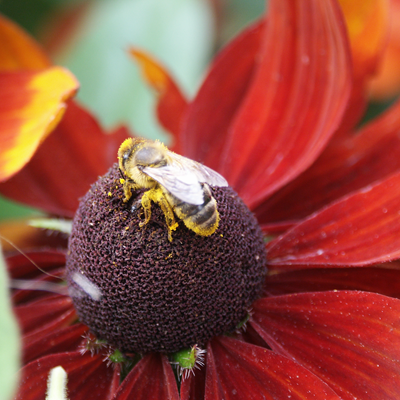
Brigit has talked to us at a previous winter meeting about bumble bees, so on this occasion, she will educate us on the lives of the solitary bees. She finds that, as she talks to people, there is a popular concept that ‘bees’ means honey, stingy things, swarms and classic white- painted WBC hives at the bottom of the garden.
To bee or not to bee – Batesian mimicry
There are thousands of striped flying insects, but not all of them are bees or wasps. Some will be flies or other insects pretending to be bees, in the hope that their mimicry of the real bees with stings will fool potential predators into leaving them alone. Hover flies are a good example. They often have prominent striped markings but are easy to for us to identify, as flies have only two wings plus their antennae are usually very short. In addition, bees always have a narrow waist.
Click to see more:
Batesian mimicry, discovered by H.W.Bates, a 19th-century English naturalist, is an evolutionary strategy where a harmless species (the mimic) evolves to resemble a harmful or dangerous species (the model) to avoid predation by predators that have learned to avoid the model. The mimic benefits from the model’s aversive warning signals, such as bright colours or a venomous sting, by being misidentified as the dangerous species and thus escaping attack.
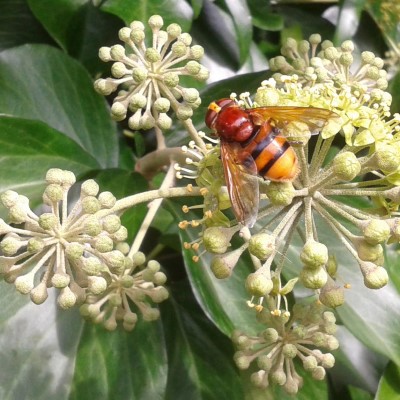
Bee mimic
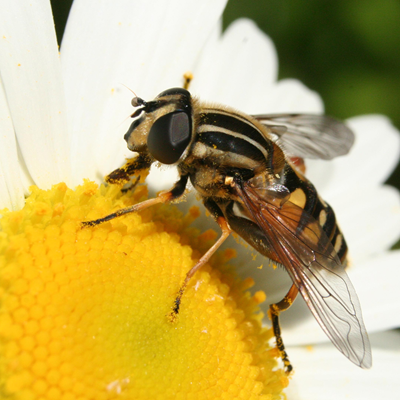
Two winged fly
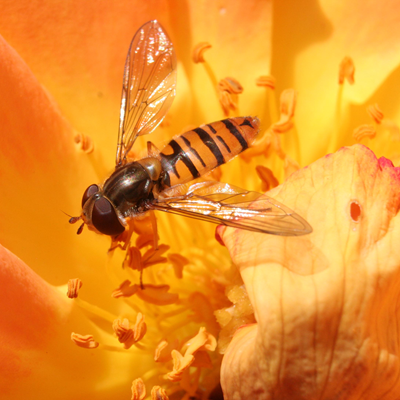
Hover fly
How many species of solitary bee are there?
To put the subject into perspective, some numbers will help to show the importance of the solitary bees.
| Worldwide | Britain & Ireland (275 described species) |
| Honeybee species – 9 | Honeybee species – 1 |
| Bumblebee species – c250 | Bumblebee species – 24 (of which 7 are on the Biodiversity Action Plan) |
| Solitary bee species – c20,000 | Solitary bee species – 250 (of which 13 are on the Biodiversity Action Plan) |
| (Stingless bee species – c500) | (Cuckoo bee species – 70) |
Social bees vs Solitary bees
In the UK, social bees comprise the honeybee and the bumble bees. They are distinguished by having multiple, overlapping generations, a division of labour into a reproductive individual and non-reproductive workers. The young are cared for cooperatively by the work force.
In the case of the honeybee, the workforce is present all year round, whereas the bumble bee workforce dies out in the autumn with only the fertilised females (queens) surviving the winter. The queens start the nest building phase the following spring.
In comparison, solitary bees do not have overlapping generations, there is no caste system of worker bees, the females are all single mothers and do all the nest building, egg laying and provisioning themselves.
Solitary bees have no social traits, but there are instances where some younger females may help older females with, say, nest guarding, then go on to build their own nests. In addition, some sites are ideal for a particular species and many of the same species of bee will congregate at these sites. See image of cobb wall below.
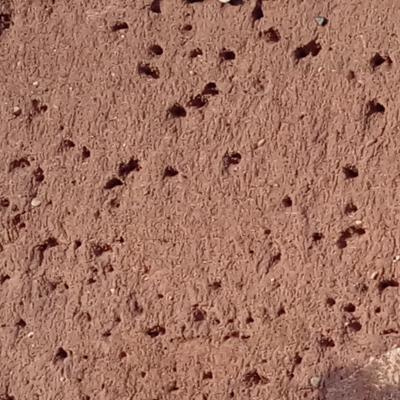
Solitary bee holes in cobb wall
These variations in behaviour illustrate the possible evolutionary pathways that led to the fully social bees.
Solitary bees have an enormous variation in size. The world’s largest known species is Wallace’s giant bee, Megachile pluto, with a wingspan of 63.5 mm. The smallest known species is Perdita minima at just under 2mm long. Surprisingly, this bee plays a vital role in pollinating native plants in the deserts of southwestern USA. There could be even smaller bees that have not been found and described.
Pollen collecting
Beekeepers will be fully aware of the way in which honey bees and bumble bees collect pollen. Pic of hairy bee
By ‘scrabbling’ around on a flower head the pollen will stick to the hairs on the bee’s body because it is electrostatically charged and may also be slightly sticky e.g., dandelion pollen. The bee then grooms itself and packs the pollen into the pollen baskets on its hind legs.
In contrast, solitary bees collect pollen on a pollen brush or scopa on the underside of the body. This has dense hairs, usually either on the hind legs or on the underside of the abdomen. These hairs are designed to carry pollen whilst the female bee is foraging.
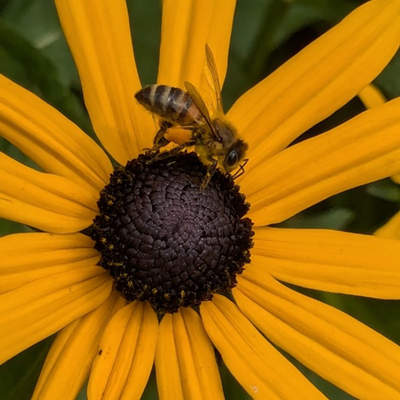
Honeybee with pollen load

Solitary bee with pollen scopa
Nesting
The ground nesters typically excavate a hole in soft ground, throwing up characteristic mounds of sand and small stones. The ground normally has to be dry and sunny so that it can warm up quickly. The tunnel often extends sideways into galleries where small chambers will be opened out for provisioning with pollen and nectar before egg laying. Cell walls are usually waterproofed with a waxy substance from the Dufour’s gland or a cellophane-like material. This helps keep the food store fresh and protects the cells against damp.
Aerial nesters are those species that typically nest in hollow stems, holes in dead wood, holes in soft mortar in walls, and of course bee hotels. The nest cells will usually be arranged in a linear sequence, with female eggs laid near the inner end and males towards the entrance, where they will be the first to emerge. The walls and partitions can be constructed of leaf pieces, mud, chewed-up leaf mastic, plant hairs or plant and tree resins. Brigit also mentioned Osmia species that nest in empty snail shells which they will disguise by sticking sand and small stones to the surface, then hiding the shell under stems and plant fragments.
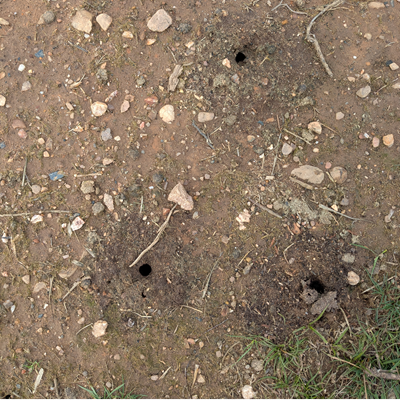
Solitary bee tunnels
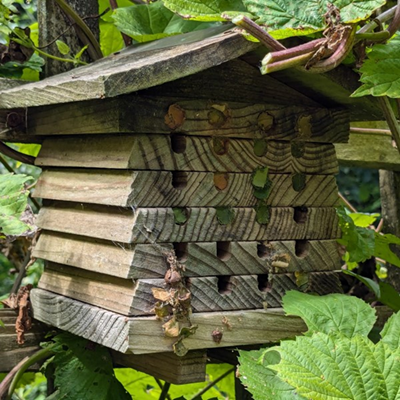
Bee hotel
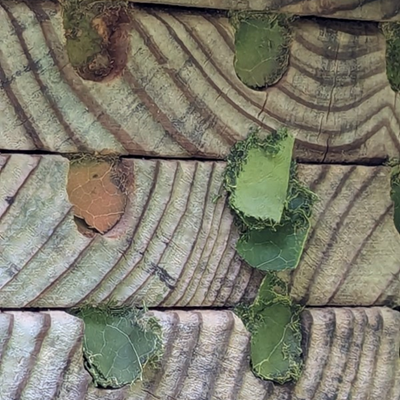
Bee hotel with sealed cells
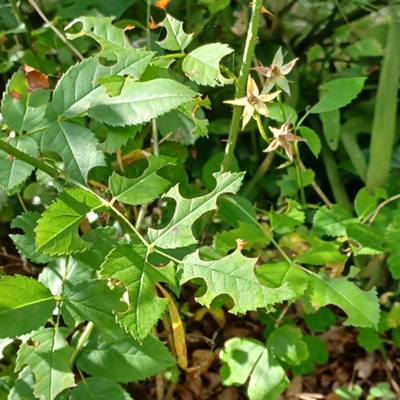
Work of leafcutter bee
What can we do about declining bee numbers?
In your garden:
- Don’t use herbicides.
- Reduce the use of fertilisers as they make the ground too fertile for wild plants.
- Climate change is pushing flowers and insects out of sync. Try a wider variety of plants to cover the gaps..
- No mow May – best with a mosaic of different habitats to suit a wider variety of species.
- Brigit’s four special favourite plants for bees:
Comfrey, Vipers bugloss, Sedum, Mahonia. - Other good plants: Alexanders, Yarrow, Wild carrot, creeping thistle, dandelion, wild mignonette.
- Don’t forget grasses are important for meadows.
- Plant fruit trees + bushes such as hawthorn and willow.
- Wild life, especially caterpillars, like nettles.
- Finally, don’t forget other pollinators such as moths. They like fragrant plants that stay open at night, e.g. stock, nicotiana, oenothera.
References
The Solitary Bees, Biology, Evolution, Conservation. Bryan Danforth, Robert Minckley, John Neff.
Plants for Bees. Kirk and Howes.
Field Guide to the Bees of Great Britain and Ireland. Steven Falk.
Our thanks to Brigit for an inspirng talk and all the fabulous pictures of solitary bees.